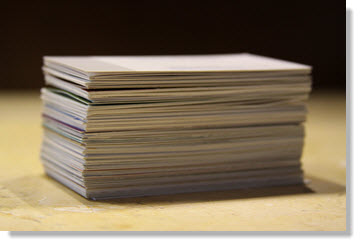Research has long suggested that the majority of leads generated by trade shows never receive follow-up by company representatives. A 2010 study concluded that fewer than 70 percent of exhibitors have any formalized plan or process in place for how leads are followed up after the show. In an era of automated lead nurturing, the situation may be improving somewhat, but simply having the technology with which to blast every trade show lead the same, tired email message instantly upon your return to the office doesn’t mean you should.
 Here are 10 tips for designing an effective trade show follow-up campaign. Note: these strategies assume that hot leads – those prospects who specifically requested follow-up or were otherwise graded as “high priority” on the show floor, get prompt response directly from sales. A follow-up campaign is one designed to address the other 90 percent of show leads, including show attendees who never made it to your booth, and to ensure that no other potentially qualified leads fall through the cracks.
Here are 10 tips for designing an effective trade show follow-up campaign. Note: these strategies assume that hot leads – those prospects who specifically requested follow-up or were otherwise graded as “high priority” on the show floor, get prompt response directly from sales. A follow-up campaign is one designed to address the other 90 percent of show leads, including show attendees who never made it to your booth, and to ensure that no other potentially qualified leads fall through the cracks.
1. Prompt response to show leads is critical. Have the campaign designed and ready to launch so that response emails can go out immediately upon leads entering the system. A prompt, professional, tailored response is a great way to make your company stand out from the competition who may take days or weeks to respond.
2. Most trade show leads are routinely ignored by sales. The best use of a follow-up campaign is to qualify leads by offering a range of options for further engagement. Any response (e.g. a white paper download, a demo request) can help uncover hot leads that might otherwise be missed, or at the very least can help sales prioritize which leads merit being called first.
3. Using the same follow-up email to every show is the surest way to get your message ignored. Be sure to always identify the specific show, by name, in the subject line and in the first paragraph, at minimum.
4. Make your call to action specific. Never say “to learn more” or “for more information.” Instead, provide the prospect specific, tangible options for engaging with your company: “download our free white paper,” “request a personal demo,” “watch our 3-minute overview video.”
5. Follow-up emails are a great place to remind the prospect of announcements you made at the show. But don’t overdo it. The last thing a prospect wants to read is a re-hashed press release. Make sure that your email is designed to drive action, not just spread the gospel about your new product.
6. Usually, marketing best practice dictates that an email focus on one offer and one call to action. Trade show follow-up emails are the exception to that rule. For example, if the only option you provide attendees is to request a demo, you’ll only hear from a small subset of leads, albeit those most sales-ready. Provide 2-3 options that appeal to a range of prospects at various stages of the selling cycle, for example: request a demo, download a white paper, subscribe to our newsletter.
7. Personalize each email with the name of the assigned rep (or SDR) for that prospect, and include the rep’s phone number and personal email at the end of the email. Someone who’s attended a tradeshow may be ready to contact sales directly. Make it easy to do so.
8. Including a photo of your booth, crowded with eager, interested prospects, can help remind attendees who your company is amongst the hundreds they talked to at the show. Just keep the photo relatively small so that it doesn’t force more valuable selling copy down the page.
9. One core email template can do double duty and cover both show leads (those prospects who registered at your booth) and also any larger list of show attendees (provided to you an exhibitor). Design, key message and calls to action can be the same; just change the introduction and any other associated language from “thank for your visiting our booth” to “sorry we missed you.”
10. Have a specific, tailored plan for ongoing nurturing to follow your initial follow-up email. Don’t just dump show leads into your marketing database or sign them up for your monthly newsletter indiscriminately. At the very least, point leads into an email track tailored for their specific product interest or vertical market. Consider a triggered program of 2-3 emails in the days following the show (offering varying types of informational content) so that prospects don’t wait weeks until they next hear from you.



